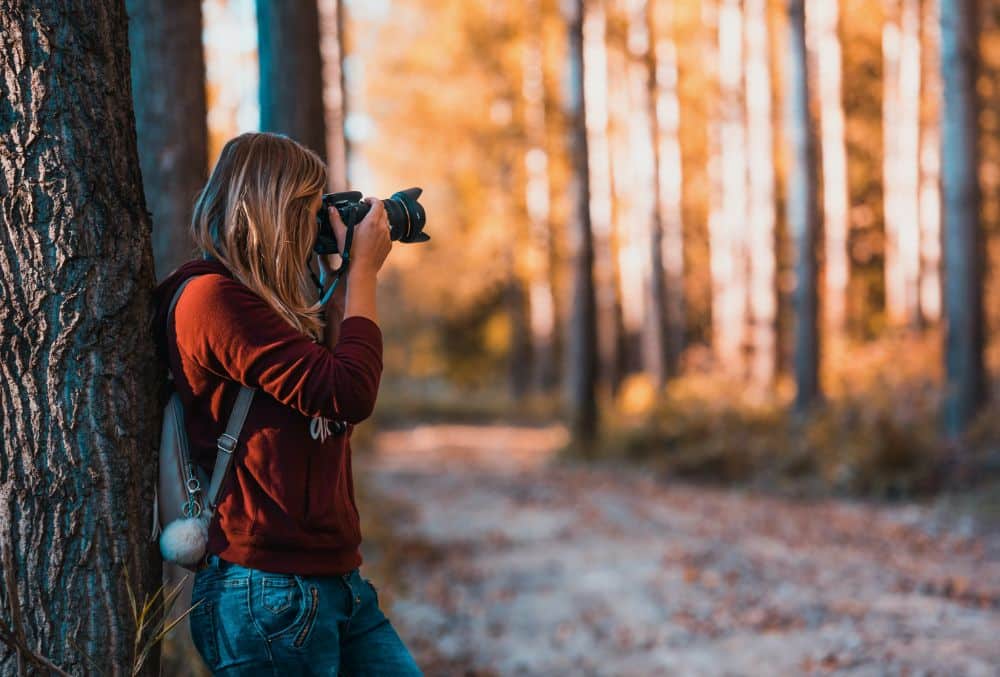This article has been contributed by Jeremy Scott Foster.
There is no denying the importance of a strong online presence. Just look at the stats – of the 420 billion people who are active on social media, over half use their preferred platforms to research products before buying.

However, there’s more to it than just being online. Today’s customers expect brands to be authentic, trustworthy, and consistent.
Here, I’ll be talking about maintaining brand consistency. Specifically, I’ll discuss how you can maintain a consistent brand aesthetic across all the visual assets you release online, whether it’s on Instagram, Facebook, Pinterest or your own website.
The Keys to Brand Consistency For Your Online Aesthetic
Before I get to the finer details of your photos, let’s talk about your branding first.
Everything you post online – from Instagram posts to Stories to everything you put up on your website – should reflect your brand aesthetic. And when I talk about your brand aesthetic, I’m really talking about your brand’s visual identity – a combination of visual elements that convey what your brand is all about.
So how do you go about creating your brand aesthetic?
Pin Down Your Brand’s Identity
At this point, you need to know your brand inside and out. To do this, go over your brand’s vision, mission, and values, and try to answer the following questions:
- How would I describe my brand?
- What is my “why” or my brand’s purpose?
- What kinds of people do I want to attract?
- What does my brand value the most?
From there, you can hone in on a theme, or a point of focus for your online presence. This way, you can find your niche and with a particular audience online.
For example, a company that sells paints could focus on the home and living niche, targeting young adults looking to elevate their living spaces. The brand could post interior design pegs that look like they were pulled straight from Pinterest, all while featuring their paints in each photo.
Another way of looking at it is by knowing your brand’s story. When you have a clear story, you give people something to look forward to or a reason to follow you.
So, if, for example, your brand is a fitness apparel line designed to make wearers excited about exercising, your visual identity should be fun and vibrant rather than muted and mysterious.
There is more room for creativity in some industries, like mine — travel. Some travel brands post moodier images, while I like to post more vibrant photos with contrast.
Create A Mood Board
If you’re having trouble nailing down an aesthetic, you can always create a mood board. On Instagram, look up brands that have similar products or messaging as your own, then pinpoint some of the visual elements that resonate with you.
Look at how other brands use color, typefaces, layouts, and photo trends to bring out their own visual identity. Pin your favorites on Pinterest so you can see everything laid out in front of you.
Build A Style Guide
A brand identity style guide is like your branding bible – it’s a document containing everything there is to know about your brand aesthetic. Referring to it whenever you create anything visual for your brand will ensure maximum brand consistency.
Most style guides will include guidelines on the color palette, fonts, layouts, filters, and templates you should use. It should also include things like rules about logo placement and the tone and voice of your copy.
Color and Light
Color can trigger different emotions in people, allowing them to build stronger associations with certain brands.
For example, Whole Foods is all about healthy and minimally processed food. So, it only makes sense for their logo to be green – a color we associate with health, nature, and growth. And when it comes to their photos, they keep things organic, with minimal editing and natural lighting.
Come up with a brand color palette for your marketing materials, and make sure you keep a list of the specific color codes to maintain consistency in all your posts.
Filters/Presets
Technically, this still falls under colors, as filters you use for your photos should still complement your visual identity and chosen color palette. When it comes to editing, I suggest using one or two photo editing programs for all your posts to maintain consistency. Most photo editing apps come with built-in filters, but it’s also good to come up with your own presets so you can tweak them just to your liking.
Other things to include:
- Font styles and typefaces
- Copywriting guidelines, including brand voice, tone, and hashtags
- Templates and default backgrounds
- Sample posts
Whenever you’re feeling lost at any point in the content creation process, it’s good to have a style guide on hand so you can get back on track right away.
Plus, when your business expands and you can hire other people to take care of content creation, having a guide means your branding remains consistent even when you’re no longer in charge of that aspect.
6 Photo Editing Tips for Maintaining A Consistent Brand Aesthetic
If you’re a one-man-marketing team with only a smartphone or a mirrorless camera at your disposal, don’t fret. Technology moves so fast these days that these cameras already measure up to the more bulky DSLR cameras of the past. The trick is knowing how to use them – and getting the editing right!
Here are 6 photo editing tips to help you maintain brand consistency in your online aesthetic.
1. Learn the Basics of Photography
You don’t have to be a professional photographer to take Insta-worthy photos – but you still need to have a basic understanding of photography to make sure your photos can hold the attention of your audiences.
Some of the key elements of photography are light, composition, and color.
Light
Light is the most important tool in photography. It helps illuminate the subject, dictate the mood and feel of a photo, and add depth and texture to a scene. With a less-than-professional setup, it’s best to use natural light. Skip the flash, because it can make an image look flat and harsh.
Composition
Composition is how you arrange objects in your frame. Good composition emphasizes what’s essential and grabs your attention. When in doubt, use the grid and follow the rule-of-thirds: place points of interest at the intersections or along the lines of the grid, thus creating a more balanced image.
Color
Finally, we have color. As mentioned, color can set the mood of a photo. For example, focusing on a subject that is yellow, or even adjusting the tint of your image to a warmer hue, can make your photo feel more joyful and vibrant. You can play with color in so many different ways, just make sure you stay true to your brand aesthetic.
Pro Tip: Most smartphones now allow you to shoot in RAW format, which gives you an uncompressed photo that retains everything your camera captures. Always shoot in RAW, because this allows you to more easily edit your photos without compromising details.
2. Presets, Recipes, Looks – These Are Your Friends
The editing process is where you can fine-tune your images to achieve a cohesive aesthetic. Here, you can adjust your image’s exposure, play with highlights and shadows, as well as crop and straighten it for better composition. This is also where you can play around with color, using saturation and color temperature to better reflect your aesthetic.
Photo editing programs like Adobe Lightroom also come with built-in filters, or presets, and even allow users to create their own. In VSCO, they’re called Recipes, and in Snapseed, they’re called Looks.
Related: Get 40-70% Off Adobe Creative Cloud
Presets make it a lot easier for brands to achieve cohesiveness, as they can be applied to multiple photos in just one click.
Keep in mind, however, that the reigning trend among brands and content creators these days is the “no-edit” edit. As influencers have taken over Instagram with user-generated content, including ads and sponsored posts, people have begun to crave more authentic, stripped-down content.
So what does this look like? Posts to look as natural as possible, with no use of heavy filters and retaining a more subdued and organic color palette.
3. Choose an Editing App and Stick to It
When it comes to post-processing, you have a lot of options, from casual apps like Snapseed and VSCO to more professional programs like Lightroom. Instagram has its own filters and editing options too, but they’re not quite as comprehensive yet as the others we mentioned.
Whatever photos editing software you choose though, it’s important to stick to one app for maximum consistency.
4. Pay Attention to Your Instagram Grid
Don’t just focus on individual photos, especially on Instagram. Think of your grid as your business’ facade – usually, it’s the first thing users see when they look up your brand online. What kind of first impression are you making with the kind of grid you have now?
A cluttered grid gives off the impression that you either don’t care enough to make your grid look good or that you don’t really know what you’re doing. One of the easiest ways to organize a grid is to create balance by alternating busy product shots with minimalist quotes.
Or, if you’re a travel brand, for example, you can alternate landscapes with portraits. That instantly brings balance to your feed.
There is a myriad of other ways of setting up your grid. What’s important is that you find a tactic that fits well with your brand. Big, white borders around each photo bring a sense of calm and neatness to a grid. Row by row grids, on the other hand, can help tell a story – or show an epic landscape photo – over multiple posts. And rainbow grids just add playfulness to your posts.
5. Don’t Forget About Your Stories
Most social media platforms have their own version of Instagram’s Stories these days, from Facebook’s My Day to Twitter’s Fleets.
Most users love Stories because they can share interesting things about their day without putting much thought into how a post could affect their overall feed. People love scrolling Stories too – they’re like a window into their friends’ daily lives.
So how can your brand take advantage of Instagram Stories? Don’t just post the same tired ads over and over again. Keep your stories fresh, timely, and interactive. Brands are using Stories to interact with their followers, show teasers for upcoming product launches or events, and post important updates.
For consistency, try using a Stories template from a design app like Canva. Make sure the colors, images, and fonts are all in line with the rest of your branding materials online.
6. Pay Attention to Trends
While it’s integral to maintain a cohesive brand image, do bear in mind that doing the same thing over and over again can get boring too. Shake things up once in a while by riding on the latest editing trend. But the mark of a good brand is one that can adapt to the latest trends, all while retaining its distinct voice.
So, what are some of 2021’s biggest social media trends? Text overlays and infographics are pretty big these days, especially as socially conscious users have turned to the app to talk about social issues through explainer posts.
Monochromatic photos are also quite trendy these days. This doesn’t necessarily mean black and white photos. Rather, brands and users have been matching subjects with similar colored backgrounds or landscapes to make for unique and eye-catching photos.
Collages and maximalist photos are also big among Gen-Z users, along with video glitches, blurs, and heavy grain effects. It’s a certain aesthetic that harkens back to the early 2000s – the period most Gen-Z grew up in and are therefore nostalgic for now that they’re growing up.
The Bottom Line
To maintain a consistent brand aesthetic online, your number one priority should be to know your brand inside and out. Once you’ve done that, you can get inspiration from all over the web – trying out different filters, fonts, and trends – without ever losing your distinct voice.
_
About the author: Jeremy Scott Foster is an adventure-junkie, gear expert and travel photographer based in Southern California. He is the Founding Editor of the adventure travel publication, TravelFreak. You can usually find him on the trail, on the road, jumping from bridges or hustling on his laptop.



